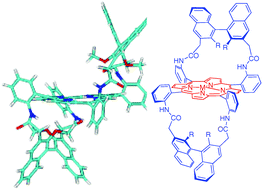The intent of this tutorial review is to cover the recent progress accomplished in iron and manganese porphyrin-catalyzed enantioselective epoxidation of terminal olefins. The literature is covered up to the beginning of 2005. In the first part of the manuscript, we will present the results obtained with simple catalysts in the early eighties, before describing the pickets and strapped series reported more recently. We will also place a special emphasis on the biomimetic approach that oriented most of this research throughout the years. As a conclusion, we will demonstrate that easy-to-prepare porphyrin catalysts should play an important role in the future and should compete with other well-known, successful systems. Among those, the popular titanium tartrate-catalyzed Sharpless–Katsuki asymmetric epoxidation allows the conversion of allylic alcohols to chiral epoxides with high enantiomeric excesses and high conversion. We will also cite the chiral metallosalen complexes independently reported by Jacobsen and Katsuki in 1990. Using manganese-salens, cis-1,2-disubstituted, trisubstituted and some tetrasubstituted olefins are efficiently epoxidized with high enantiomeric excess. However, they suffer from two major drawbacks. They often require low temperature for the epoxidation of monosubstituted (57% ee for styrene at 5 °C; 80% at −78 °C). More importantly, they proceed with low turnover numbers, TON (TON ≈ 40 for styrene). More recently, a new approach involving metal-free chiral dioxiranes was also reported. In some cases, they constitute an interesting alternative to the more common systems previously discussed.
Compared to the three pre-cited systems, chiral metalloporphyrins allow the enantioselective epoxidation of unfunctionalized terminal olefins with high enantiomeric excess (>97% ee for styrene) and impressive turnover numbers (>16000) when PhIO is used as oxidant. These results highlight the remarkable potential of porphyrin-based catalysts.


 Please wait while we load your content...
Please wait while we load your content...